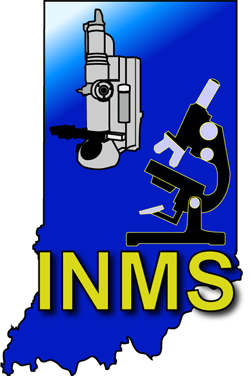
Indiana Microscopy Society
An Affiliate of the Microscopy
Society of America

|

|

|

|
 |

|
 |

|

|

|
Indiana Microscopy SocietyAn Affiliate of the Microscopy
|
|
Gregory D. Smith*, Jie Liu*, Christina Milton O’Connell*, and Michelle Husain‡
*Indianapolis Museum of Art, 4000 Michigan Road, Indianapolis, IN 46208
‡Carl Zeiss NTS, LLC. Carl Zeiss Group, One Corporation Way, Peabody, MA 01960
Cross–section sample analysis is essential for obtaining layered structural and compositional information on many kinds of artworks, especially paintings. Here we present the cross–section sample analysis of an oil painting on canvas. The painting, The Madonna Appearing to St. Philip Neri, was created by Italian artist Sabastiano Conca (1680–1764) in 1740. It has previously been heavily restored, and numerous losses and fills were detected in the X–radiograph. The radiograph also shows that a thick impenetrable white fill material, probably lead white pigment (2PbCO3·Pb(OH)2), was applied over the entire lower area of the painting during a previous restoration probably to cover losses and damages. The conservator charged with preparing the painting for an upcoming exhibition had two main questions for which cross-sectioning was warranted: Are there any original paint layers under the lead white fill, and if so, does the original layer show the same image as the restored layer? To answer these questions, five micro–samples were removed from the lower area of the Conca painting and prepared as epoxy mounted cross–sections.
“Shuttle & Find” is a correlative light and electron microscopy system, which is convenient for analysis of cross–section samples since it combines the optical properties of light microscopy (LM) with detailed structural and chemical analysis from the scanning electron microscope (SEM) with energy dispersive X–ray spectroscopy (EDS). LM shows the optical appearance of layered structures in the samples, while SEM-EDS provides information on pigment particle shape, size, and chemical composition within the different layers. “Shuttle & Find” also enables precise relocation of ROIs between the LM and SEM.
LM results revealed that all cross–section samples from the Conca painting have similar layered structure and that there are original paint layer(s) under the lead white fill. SEM and EDS images illustrate the pigment particles sizes and chemical information. Moreover, the exact overlay of the LM and SEM images using “Shuttle & Find” has indicated the possible existence of nascent saponification reactions of some lead white particles mixed into the original oil paint and ground layers. This information regarding the history and condition of the Conca painting guided site specific excavation of the old fill material to uncover original paint layers. The painting in its restored state is now on view in the museum’s galleries.
Gregory Smith obtained an undergraduate education at Centre College of Kentucky in chemistry and anthropology. He continued his studies in science and archaeology at Duke University before earning his doctorate in analytical chemistry. During this time, he served as a field supervisor at two archaeological excavations in Israel’s Galilee region. Following his doctoral studies, Dr. Smith was a Marshall Sherfield Scholar at University College London, a postdoctoral researcher at the National Synchrotron Light Source, and the Samuel Golden Research Fellow at the National Gallery of Art in Washington, DC. In 2005 he became the first Andrew W. Mellon Professor of Conservation Science at the graduate training program for art conservators at Buffalo State College. In 2010, Smith joined the Indianapolis Museum of Art as Senior Conservation Scientist to design, outfit, and operate a 3000 ft2 facility for applied research into the museum’s encyclopedic collections and to perform basic science into the degradation of artists’ materials. His research interests span the field of conservation and include degradation reactions of inorganic pigments, treatment strategies for modern artists’ materials, and the use of analytical techniques in authentication studies.
Close this window